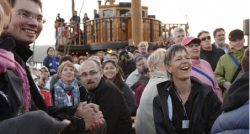The Oslo Science Conference, held 8-13 June 2010, marked the conclusion of the International Polar Year (IPY), which ran from March 2007 to March 2009. Under the auspices of the International Council for Science (ICSU) and the World Meteorological Organization (WMO), the IPY Joint Committee decided to hold an international wrap-up conference to present results and facilitate interaction between IPY participants. The conference, which represented the largest ever gathering of polar researchers, was scheduled for 2010 to allow researchers time to prepare results from their investigations.
Major Stakeholders
- International Council for Science (ICSU)
- World Meteorological Organization (WMO)
- Scientific Committee on Antarctic Research (SCAR)
- International Arctic Science Committee (IASC)
- IPY Joint Committee
- IPY Program Office
Norway was awarded responsibility for arrangements of the IPY-Oslo Science Conference (IPY-OSC). The Research Council of Norway, the main funding agency for Norwegian IPY projects, organized the conference with Olav Orheim (Research Council of Norway) as project leader; Asgeir Knudsen (independent consultant) as project coordinator; and Kristen Ulstein (Research Council of Norway) in charge of outreach and communication. An international Steering Committee, chaired by Orheim, was established with representation from each major stakeholder (see box, above, for list of stakeholders).
The conference was organized around six themes selected by the Steering Committee. The themes and their appointed chairpersons were:
Linkages Between Polar Regions and Global Systems; Harald Loeng, Institute of Marine Research, Norway
Past, Present, and Future Changes in Polar Regions; Valérie Masson-Delmotte, Laboratoire des Sciences du Climat et de l'Environnement, France
Polar Ecosystems and Biodiversity; David Hik, University of Alberta, Canada
Human Dimensions of Change: Health, Society, and Resources; Sverker Sörlin, Swedish Institute for Studies in Education and Research (SISTER), Sweden
New Frontiers, Data Practices, and Directions in Polar Research; Chuck Kennicutt, Texas A&M University, United States
Polar Science Education, Outreach, and Communication; Louise Huffman, Antarctic Geological Drilling (ANDRILL), United States
Proposals were solicited from the IPY community for sessions under the six themes, from which 41 sessions were selected. Co-conveners for each session included an early career scientist as part of special efforts made to attract young researchers to the conference. The science community was invited to submit abstracts and 2,200 persons responded by submitting a total of 2,650 abstracts for presentations at the conference.
Approximately 2,300 participants attended IPY-OSC from 49 different nations. The conference included 1,054 scientific presentations and roughly the same number of posters. A special session entitled 'PolarCINEMA' had almost 30 hours of continuous screening of polar films produced during the IPY. Various groups with polar interests held side events in conjunction with the conference. These included an international Polar Teachers conference attended by approximately 120 teachers from 20 countries, and an early career professional development workshop organized by the Association of Polar Early Career Scientists (APECS) for more than 400 young researchers.

Resources from the IPY-OSC are available online. All plenary lectures were web-streamed, and archives can be viewed on the conference website: http://ipy-osc.no/live.
One additional major IPY conference, "From Knowledge to Action," is scheduled for 22-27 April 2012 in Montreal, Canada. The 2012 conference will emphasize synthesized knowledge and the actions that should follow.
For more information, see the IPY-OSC website at: http://ipy-osc.no/ or contact Olav Orheim (oo [at] rcn.no).
IPY-OSC Participant's Perspective
by Rune Storvold, ARCUS Board Member
For a polar scientist, the IPY-OSC presented the opportunities we had previously only dreamed about. After four intensive years of planning, data gathering, initial data analysis, and many small project meetings the Oslo Science Conference was a chance to put things into perspective. The span of the conference was overwhelming, but offered invaluable opportunity to observe presentations outside my immediate field of work. IPY-OSC was also an opportunity to meet and discuss the future with colleagues. Although the International Polar Year is formally over, its legacy in terms of data and new observing networks give us renewed energy to address the crucial issues of how to live with a changing climate and predict and understand the mechanisms behind the changes. In two years we'll meet again in Montreal, with new results and new ideas. Maybe there will be a Polar Decade to plan.
